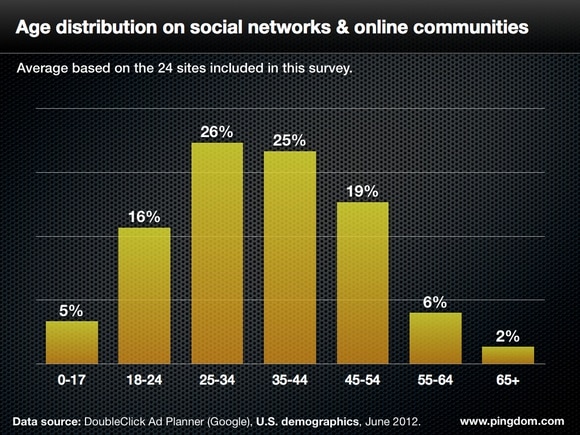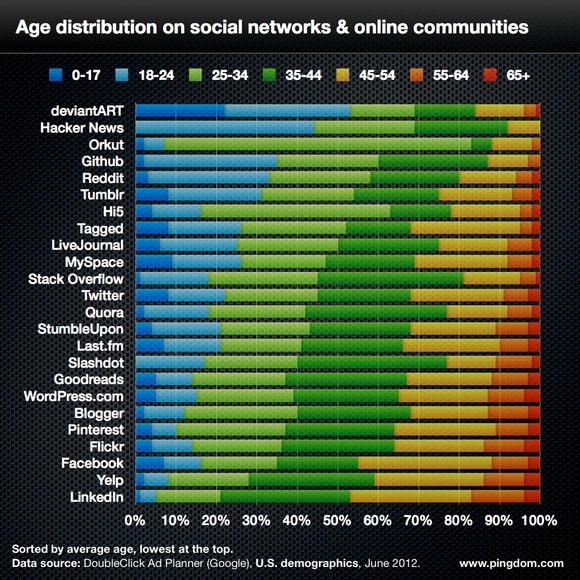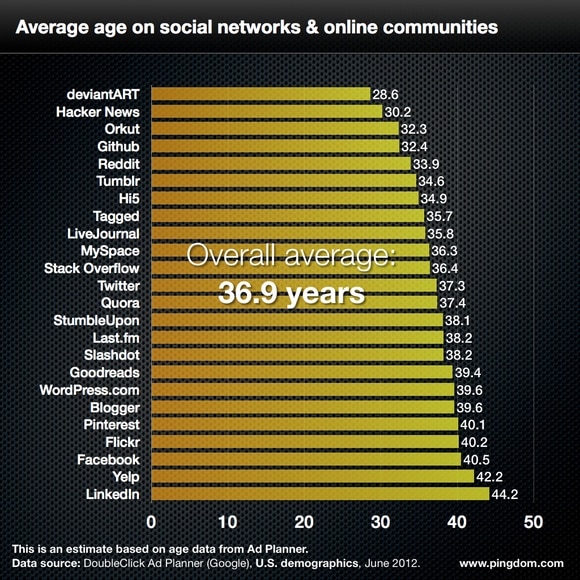
UPDATE: There is a more recent post available, Social network demographics in 2017, a lot has happened since 2012.
Do you know how old the average Twitter or Facebook user is? Do you know what share of Reddit’s users are women? We could go on and on; when it comes to social network demographics, the questions are endless. This article is going to answer those questions for you, showing you the age and gender distribution on 24 of today’s most popular social networks and online communities.
The sites included in this survey are: Facebook, Twitter, LinkedIn, Pinterest, Tumblr, Reddit, Hacker News, Slashdot, Github, Stack Overflow, Orkut, Quora, WordPress.com, Blogger, Flickr, Myspace, Tagged, Hi5, LiveJournal, Yelp, deviantART, StumbleUpon, Goodreads and Last.fm.
You may note one glaring omission: Google+. Unfortunately for us there is no data on Google+ in DoubleClick Ad Planner, the Google-owned tool we used for the demographics data. Another thing we should point out is that the demographics data used in this survey is for the United States.
With that out of the way, let’s dive into the data!
Average age distribution
If you average the age distribution across all the sites in the survey, this here below is what you end up with. You could think of it as the age distribution in the social media sphere.

More than half of these social media users are between 25 and 44 years old.
This, however, was just an average. When looking at the individual sites in this survey, there are considerable differences.
Age distribution per site
As we just mentioned, there are big differences in the age demographics of the individual sites. You can examine all of them in the chart here below.
We’ve sorted the chart by average age (more on that farther down), “youngest” site at the top.

This chart should make something very clear; social media is most definitely not just for the young. Some examples:
- 55% of Twitter users are 35 or older.
- 63% of Pinterest users are 35 or older.
- 65% of Facebook users are 35 or older.
- 79% of LinkedIn users are 35 or older.
However, as you could see in the very first chart of this article, only 2% of social media users are 65 or older (averaged between the sites in this survey).
There is also the flip side of the coin to consider; some sites have a considerable bias toward younger users. A few examples:
- 58% of Reddit users are under 35.
- 60% of Github users are under 35.
- 63% of Hi5 users are under 35.
- 69% of Hacker News users are under 35.
- 69% of deviantART users are under 35.
- 83% of Orkut users are under 35.
A couple of examples of sites with more homogenous user bases, age wise:
- Hacker News has almost half of its users (44%) in the 18-24 age bracket.
- Orkut on the other hand has a massive grouping of people aged 25-34. This is so large (76%) that we suspect it may be an anomaly in the Ad Planner data. None of the other sites display such extremes.
- More than half of DeviantART’s users are below 25.
Average user age per site
Based on the sites in this survey, the estimated age of the average social media user is just under 37 years old. Here are some other observations:
- The oldest users. LinkedIn has the oldest user base, with the average user being 44.2 years old.
- The average Facebook user is 40.5 years old.
- The average Twitter user is 37.3 years old.
- The age trend for Facebook and Twitter. Compared to a previous survey we did 2.5 years ago, the age of the average Facebook user has gone up two years, while the age of the average Twitter user has gone down two years. In other words, Twitter’s user base is getting younger, while Facebook’s is getting older.
And here is the full chart with all the sites, sorted by average age:

What about gender?
This whole article so far has been about the age of people using these social networks and online communities. Now it’s time to examine the male-female ratio, or gender balance if you prefer that word.
Based on the United States demographics data (from Ad Planner) there is a clear gender imbalance on many of these sites. Some are much more male dominated, and vice versa. However, when you look at all the data together, it becomes clear that women rule social media. More than two thirds of the sites in this survey have more female than male users.
Other observations:
- 17 out of 24 sites (71%) have more female than male users.
- The average gender distribution is 48.75% male, 51.25% female.
- Most male-dominated site? Slashdot (87% males) is the standout, followed by Hacker News (77% males) and Stack Overflow (76% males). In general, the more tech-focused sites in this survey have more male users than female.
- Most female-dominated site? Pinterest (79% females) is in a league of its own, followed by Goodreads (70% females) and Blogger (66% females).
- Facebook and Twitter have the same gender distribution: 40% male, 60% female.
Here below is a chart with the male-female ratios for all 24 sites included in this survey. The chart is sorted, the least male-dominated sites at the top.

As you can see, the only sites in this survey with more male than female users are Quora, Reddit, Orkut, Github, Stack Overflow, Hacker News and Slashdot.
Final notes
We hope you found this report interesting. It’s easy to get lost when digging through this kind of data, but we hope we managed to present it in a way that gave you a decent overview of the situation today.
To us, one big takeaway from this report is that there’s a place for everyone in today’s social media landscape. These sites have users that span the entire age spectrum, and there really are no limits to what you can achieve online, regardless of age or gender.
A note on the source data: All the demographics data in this survey is for the United States, but the patterns shown here should translate roughly to other countries as well. That said, there are regional differences, so keep that in mind if you’re applying this to other parts of the world.
Previous surveys: We did a couple of similar surveys almost three years ago (age, gender), but the results are not easy to compare since a different set of sites were used (the social media landscape has changed).
Larger charts: Average age distribution, Age distribution per site, Average age per site, Gender distribution.
Image credit: Top image background via Shutterstock.
























